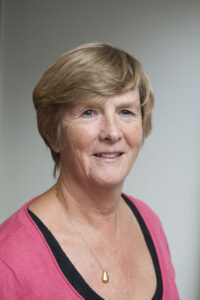
Professor Gail ter Haar, PhD, is a renowned expert who works at the intersection of focused ultrasound and physics and leads the therapeutic ultrasound team at The Institute for Cancer Research (ICR), where her work centers on understanding how ultrasound interacts with tissue. Her most recent research has involved developing devices and protocols for ultrasound-based treatments of cancer, investigating focused ultrasound for immune stimulation, and using focused ultrasound to treat liver and kidney tumours. In 2014, her team at ICR – along with colleagues at the Royal Marsden Hospital – were recognized as the first Focused Ultrasound Center of Excellence in Europe. Currently, her team is involved in a Foundation-funded trial aiming to use focused ultrasound to resolve twin-twin transfusion syndrome (TTTS).
Prof. ter Haar is the founding President of the International Society for Therapeutic Ultrasound (ISTU), and she leads the UK-based ThUNDDAR (Therapy Ultrasound Network for Drug Delivery and Ablation Research) network, which promotes collaboration between British and European groups working with therapeutic ultrasound. She is also an honorary member of the British Medical Ultrasound Society (BMUS) and the Society of Thermal Medicine (STM), honorary fellow of the American Institute for Ultrasound in Medicine (AIUM), and fellow of the Acoustical Society of America (ASA), the Institute of Physics and Engineering in Medicine (IPEM), and the Institute of Physics (IoP).
Prof. ter Haar studied physics at the University of Oxford and received her master’s degree in medical physics from Aberdeen University. She earned her PhD in physics at Guy’s Hospital and holds a DSc in clinical medicine from Oxford. She has recently been awarded both a Visionary Award by the Focused Ultrasound Foundation and the Peter Mansfield silver medal by the IoP in recognition of her work in therapeutic ultrasound.
Read the following Q&A to learn more.
When and how did you get interested in focused ultrasound?
I was drawn to ultrasound because of its versatility. There is no other form of energy that can be used not only to form sophisticated images and stimulate beneficial functional responses in tissue, but also to ablate localized targets, all noninvasively. I got into the field early on in my academic career working on the fundamental principles of high-intensity focused ultrasound (HIFU) before we treated our first patient in 1996 at The Royal Marsden Hospital with a homemade system. It has been a privilege to be able to work in this field, which requires an understanding of thermal and mechanical effects, and to help develop techniques that have a very real impact on patients’ lives.
What are your areas of interest in focused ultrasound?
My team is working in several areas:
- Exploring the potential for cavitation-based treatments to treat pancreatic cancer, especially through stimulating the immune response and enhancing the uptake of oncolytic viruses
- Investigating the use of HIFU to occlude the anastomoses involved in TTTS
- Investigating therapy ultrasound’s potential to improve drug delivery to the paediatric brain for the treatment of diffuse midline glioma
- Ensuring that therapy ultrasound exposures are properly quantified and described in order that treatment descriptions can be standardized
- Conducting preclinical studies to optimize histotripsy
- Raising funds to begin treating head and neck cancer
What is the goal of your work?
My overarching goal is to get therapy ultrasound into the clinic in order that anyone who can benefit has access to it. I believe it has a huge potential that has still to be realised. We just need to identify the conditions in which therapy ultrasound will have the greatest impact.
What are your funding sources?
Our work has been funded by the Focused Ultrasound Foundation, the UK Research and Innovation Engineering and Physical Sciences Research Council (EPSRC), the UK Research and Innovation Medical Research Council (MRC), and The Cure Starts Now.
Who are your team members and your internal and external collaborators?
I have a small team, but their expertise is extraordinary. Dr. Ian Rivens (who did his PhD with me) is a physicist expert in technical aspects of therapy ultrasound research. Richards Symonds-Tayler is a systems engineer expert responsible for building the new devices we develop. Dr. Petros Mouratidis is an expert in immunotherapy, working primarily on pancreatic cancer treatments. We currently have three PhD students as well.
What are your greatest achievements? Any major disappointments?
Getting HIFU treatments into the clinic, especially those delivered using devices designed and made at the ICR, has been a great achievement. Our recently started clinical trial for the treatment of TTTS is particularly exciting. The biggest disappointments come from not being able to progress to the next stage of a trial due to lack of funding.
What do you see as impediments to your success?
The lack of funding, especially for transitional stages of clinical treatments, is an impediment. There is also a lack of clinical research time for our clinical colleagues due to the stringencies of the current NHS.
What is on your research wish list?
- Funding to develop the treatment of head and neck tumours by therapy ultrasound
- Funding to establish a 5-year fellowship for Ian Rivens to support the technology involved in our therapy ultrasound work, as any good team needs someone in this role
- A system to investigate histotripsy clinically and preclinically
Does the Foundation play a role in your work?
Very much so. In addition to our Center of Excellence status, we have also had several small grants for pilot projects. Without these we would not have made the progress we have.
How many patients have you treated?
We have treated approximately 65 patients in four different clinical trials at ICR, and approximately 30 patients with the Oxford HIFU team.
Do you have any clinical or clinical research highlights?
Most recently, our first treatment of TTTS has been a clinical research highlight.
